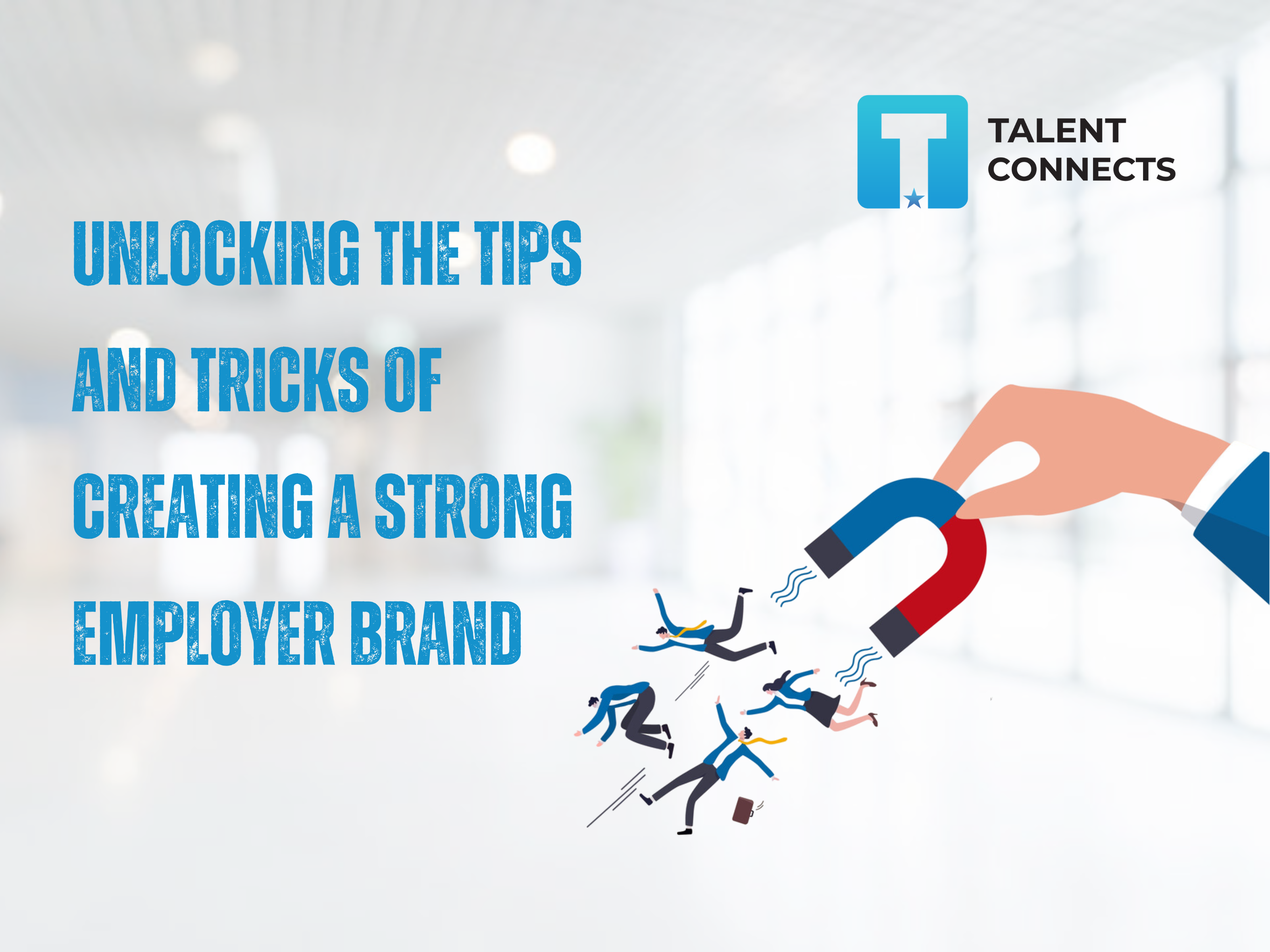Unlocking the Tips and tricks of creating a Strong Employer Brand
Employer branding was first coined by Sam Barrow in 1990. The concept essentially emerged in the 90s as employers had to differentiate themselves because the competition for talent was increasing. The scope of the concept was only limited to recruitment back then.
It was only in the early 2000s that the organizations realized that they had to also retain and motivate the talent pool they acquire. As a result, the scope of employer branding broadened and elements such as corporate culture, employee engagement, retention strategies, etc. came under the umbrella of employer branding.
The mid 2000s was the era of digital social media, which significantly impacted employer branding. Social media, digital promotion were new ways through which companies could reach a wider pool of audience and position themselves as employers of choice.
Presently, companies have adopted a more employee centric approaches by welcoming diversity and inclusion, work life balance, career developmental opportunities. Companies still use various digital means to advertise themselves and position themselves as the best place to work.
The concept of employer branding has evolved with time and will probably continue to do so in the future. From having a limited scope as a way to only attract talented pool of employees to now considering and catering to personalized experiences to retain as well as motivate the employees, it has come a long way.
In marketing terms branding determines the worth a brand is in the minds of the customers. Through branding efforts companies try and convince the employees that they are the best among a sea of other brands.
In an organizational context too, an employer is a brand that is branding in a similar way to attract customers in forms of potential candidates and the employees and make them feel like their employer has the best to offer to them amongst all other companies/ brands.
Companies can involve in employer branding through many different ways showcasing their work culture, their benefits. They can be actively engaged in employer branding through videos, artistic narration, etc. It can also be spread through word of mouth by the employees that already work or have worked in the organization.
While employer branding in the west is very much in practice, many Nepali organizations haven’t yet realized the importance of the same.
Why is Employer Branding Important?
The changes in the demographics and economic conditions in a developing nation like ours have given rise to a competitive labor market. Similarly, the median working population of the county is millennial whose attrition rates are usually high, because they are notorious for job hopping. So, investments need to be made in attracting as well as retaining suitably qualified and skilled employees.
Likewise, the trend of the millennial population fleeing the nation in search of better opportunities is ever increasing. It wouldn’t be wrong to say there might be a time in the near future where the country might lack manpower for even the basics of tasks. Even now, many mid to large sized companies and MNCs have been paying huge salaries and brining foreign diasporas to fill the c-suite roles because Nepal lacks the manpower and skills. This is a huge cost the company has to bear as the diasporas have to be provided with various benefits and perks for working in a foreign land. Companies can half the cost of the salaries they pay to the diasporas if they are able to attract the local candidates.
This is where the role of employer branding is so important. An employer branding essentially is a way to showcase that a company has unique culture, values and highlight various benefits and opportunities. The goal is to portray an image of a company such that it is seen as a workplace that is best fit to work at/for in the minds of employees and potential candidates.
Having said that, presenting benefits and making promises that cannot be delivered isn’t recommended at all. Also, one noteworthy factor is that employer branding cannot and will not be good because an organization boasts a very high financial reward. A holistic system of total reward that encompasses pay, benefits, learning and development opportunities and good work environment have a big role to play in positive employer branding.
So, in its essence, employer branding is very essential to attract, motivate as well as retain the employees.
Similarly, Unilever Nepal an MNC that that offers its employees variety of perks and facilities such as employee assistance programs (EAPs), 24/7 mental health and work life support help lines has been the number 1 employer of choice for 4 the past years, as per the company website. This also shows how investing in employer branding can be beneficial for companies.
On the other hand, there are also companies in the country, without naming names that have negative employer branding because of the toxic work culture they have.
Employer branding is very essential to reduce turnover or to avoid hiring the wrong candidate in the first place. As and when a company is able to communicate the way things are in the company, candidates that resonate to the culture and norms only apply to the company. Thus, reducing or minimizing the hiring costs too.
Positive employer branding also makes employees feel a sense of pride as they have themselves associated with a company that holds positive reputation in the market, leading to loyal and engaged employees.
If we look at it from a different lens, a good employer branding could also pave way for new and sustained business partnerships. Because why would one company want to partner with another company that has a negative employer branding, right?
Employer branding techniques:
Like different brands use different branding techniques to attract and retain new and existing customers, companies under different industries must also use different employer branding techniques to attract and retain new and existing employees.
Some of the popular techniques companies all over the world have been using are:
1. Ambassador programs:
Organizations initiate employee ambassador programs to utilize their employees as advocates for their brand and to promote it within the broader community. The aim of employee ambassador programs is to create awareness, trust, and reliability for the brand by using genuine and compelling communication with customers, potential customers, and the general public.
2. Showcasing company culture:
By means of employee-generated content, such as testimonial videos, social media posts, or blog articles, companies can showcase the prevalent culture of an organization. This provides an authentic picture of the company culture, and allows prospective employees to check whether their values match with that of the organization.
3. Compensation and rewards:
While company culture, work life balance all play a part in deciding whether to join or not to join an organization, compensation and rewards still top the list. More so in a salary sensitive culture like ours, direct and indirect financial rewards play a huge role in attracting and retaining candidates. Thus, companies need to do their best to establish pay rates that are above the market standards or at least be at par with the market rates.
One common notion of misconception when it comes to employer branding is that it must be expensive and thus only be used by the large corporate or businesses, which is completely false. Even small organizations or SMEs can use employer branding techniques and as a result have a very good pool of employees.
If a company, be it large or small has the following aspects analyzed, can use employer branding techniques to attract and retain employees:
4. Labor market mapping:
By gaining a better understanding of the trends and the skills gap that are in market, employers can position themselves as leaders or desirable employers in that very market.
5. Attraction analysis:
People of different job markets will have different attraction factors. While direct financial rewards can be a major attraction factor for some, indirect rewards can be the same for the other. Thus, analysis of what the market finds attractive and then catering accordingly is very important to attract good candidates.
6. Promoting the Employee Value Proposition (EVP):
EVP refers to the offerings the company provides to its employees in exchange for their knowledge, skills, experience. The offerings can be a combination of unique rewards and benefits.
Having EVPs is one thing, but the company has to spread the word. To do so, they can deploy contents on various social media platforms.
As we have already discussed about the median working age population of the country being millennial, flexible working, career development opportunities, etc. can be some good examples of EVPs for them. Likewise, EVPs can be different for people working in different industry.
7. Best practice benchmarking:
While one size fits all technique isn’t the way to go about for companies in every industry, companies in the same industry can benchmark and tweak similar offerings already in practice to attract and retain candidates.
By: Sarun Ghimire
-HR Department, Talent Connects



